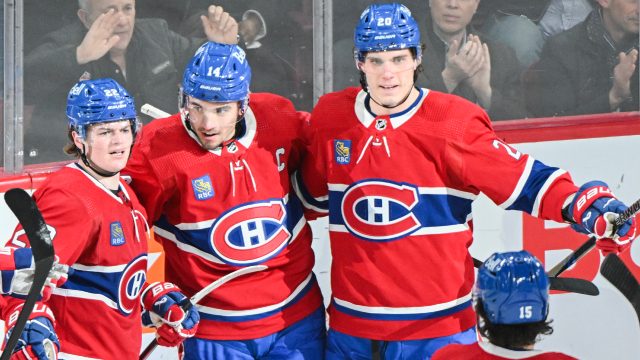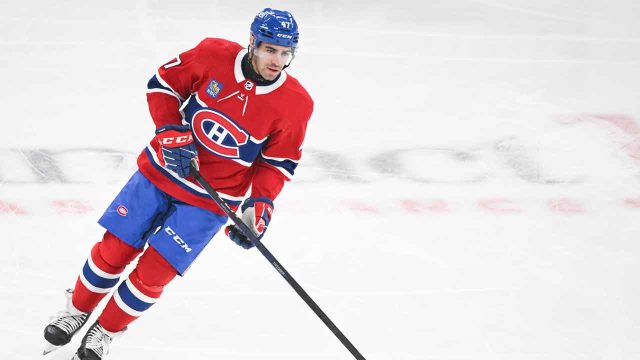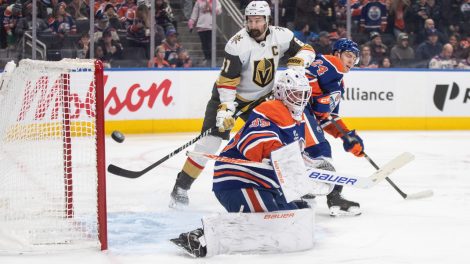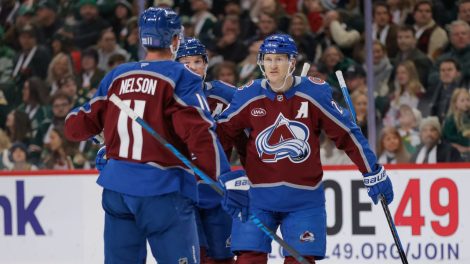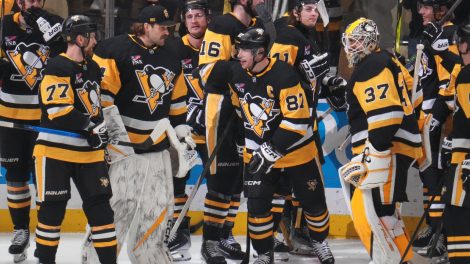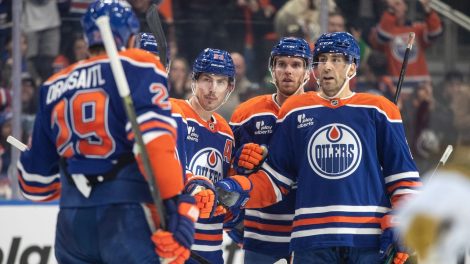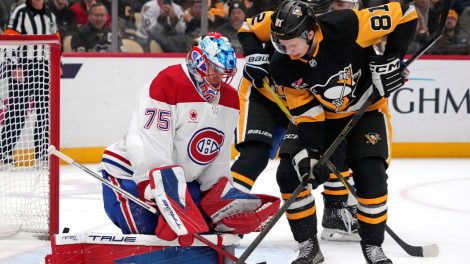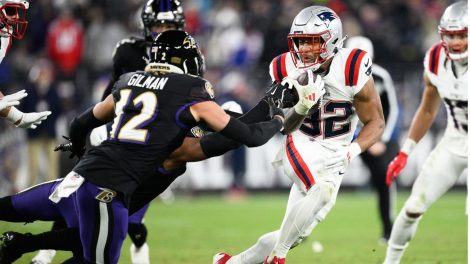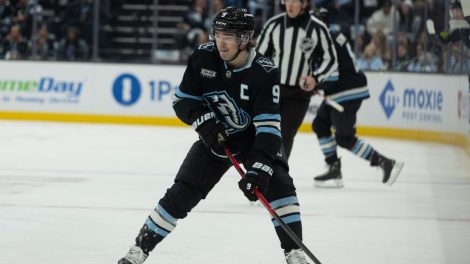BROSSARD, Que. — We wouldn’t say that Jeff Gorton and Kent Hughes spent 40 minutes Wednesday exclusively tempering expectations so much as we would suggest they were wisely trying to strike the delicate balance between optimism and realism in laying out how they’ll navigate the trickiest steps on their path towards continuing to properly rebuild the Montreal Canadiens.
It’s what they had to do, mere hours after their season ended, to reinforce they know that sprinting and slipping at this stage would be catastrophic, lest they fall into the same trap so many around them—in the Atlantic Division alone—have before them.
Just two hours west, down the 417 Highway, is a giant caution sign the Canadiens must heed. It’s where Pierre Dorion declared last fall the Ottawa Senators’ reconstruction was complete after making some aggressive summer moves but not making enough of the right ones.
Look where he ended up by November, and where the Senators finished in April.
Further west, down a different road, are the hapless Buffalo Sabres, who appeared ready to bust a 12-year playoff drought but instead plunged further into seemingly interminable misery by making more ill-timed and wrong turns. The nearby Detroit Red Wings, who were the models of patience before taking a similar step a season ago to the one the Canadiens just took, loaded up on veterans who ultimately landed the team an inch short of its first playoff berth since 2016 — and possibly took it further away from where it hopes to get to over the coming years.
Gorton and Hughes aren’t looking to follow.
That doesn’t mean they don’t want to do everything they can to get the Canadiens to next year’s playoffs.
Both of them talked at length about their commitment to that, acknowledging they’ve collected the assets and accrued the cap space to make moves that help advance the team closer should the right opportunities arise.
But they also made it clear they won’t do anything just for short-term gain that potentially obstructs their long-term plan.
“Say we had a chance to go sign or trade for a right-handed veteran defenceman who makes us better for next year,” said Hughes. “We won’t do it if it blocks (Logan) Mailloux or (David) Reinbacher the opportunity to progress in the NHL.”
The GM added he wouldn’t keep Lane Hutson in the Canadiens’ lineup for a better chance at a playoff spot if he felt his long-term development would be better served playing in the American Hockey League next season.
Because neither he nor Gorton are aiming for just making the playoffs.
“We didn’t come here to work here to have fun, we came here to win,” said Gorton, who serves as executive vice-president of hockey operations.
He was talking about the Stanley Cup, which Hughes said the Canadiens—as currently constituted—remain far away from.
The challenge now is to do as much as possible to spring the team forward for now without doing something that would take them further away becoming a perennial contender down the line.
“This is the part, right now, where it’s probably going to be the hardest,” said Gorton, and he was right.
Though there was nothing easy in the process over the last couple of seasons that’s led Canadiens management to having the opportunity to transition to the team-building phase so soon.
Gorton and Hughes beefed up their infrastructure, invested in analytics, remade their amateur scouting department, installed a far more robust development staff, put one of the most progressive coaches in the NHL behind their bench, and all those of those moves have led to the development of a culture that has advanced them quickly.
It’s a culture they’re proud of. A culture that led to a far more competitive season, in spite of similar results to the one prior, with the group and many of its individuals taking big steps forward and serving notice they’re a team on the rise.
That will help Gorton and Hughes with what comes next.
“I think Montreal is going to be a place where players want to play,” Gorton said. “I think we’re hearing that more, and I think Marty (St. Louis) is a big part of that. We’re not naïve to think it’s us. But I think our players—we have a really good group of guys, of real high-character people you deal with every day. You can see it, and we can see it, and it’s exciting.”
The defence is overflowing with young talent and has a balance to it—both in dimension and experience—that won’t require much (if any) tinkering.
Up front, as Gorton noted, captain Nick Suzuki proved he’s a No. 1 centre, posting 33 goals and 77 points, putting up favourable underlying numbers against the top centres in the game, and driving a line that produced more offence at five-on-five than any other in the league from the Mar. 8 trade deadline through the end of the season.
Cole Caufield’s down year from a production standpoint—he still managed 28 goals and 65 points, which were career highs—was offset by his growth into a far more complete player. And Juraj Slafkovsky became a player Suzuki said he believes could become a top-five winger in hockey.
Gorton wasn’t as hyperbolic in his assessment of the player the Canadiens chose first overall in 2022, but he did quip, “maybe 12 months ago in this room people were maybe looking at us like we didn’t know what we’re doing, but now it’s a year later and he looks like he’s going to be a really good player.”
Alex Newhook, who came over last summer via trade with the Colorado Avalanche, looks like one too.
He finished a season interrupted by a 12-week absence due to a high-ankle sprain with 15 goals and 34 points in 55 games.
“He proved a lot,” said Suzuki of Newhook. “I didn’t know if he could play centre. He kind of struggled playing centre early, and lately he’s been unbelievable. With his defence, offence, and driving his line, I think he turned into a really good centreman over the last couple of months.”
“He did a lot this year,” added Caufield. “He played wing, played first line, second line, third line, played down the middle. He does a lot. He brings energy, just his attention to detail—obviously he’s won before. You can trust a guy like that. He’s very fun to play with, very fun to be around, so good for our culture, good for our group and does all the right things and is a guy you want on your side.”
Another is Kirby Dach, who missed all but five periods of the season after blowing out the anterior and medial collateral ligaments of his right knee in a Game-2 collision with Chicago’s Jared Tinordi.
“I think it goes without saying we missed him a lot this year in so many situations because of how good of a player he is,” said Canadiens assistant captain Mike Matheson of the former third-overall pick in 2019. “He can control the puck so well, he creates so much for the other players on the ice because of all the attention he brings to himself with the puck, so the easiest way to say it would be we missed him this year for sure.”
But Dach will be back next fall, eager to join Newhook—and whoever else Gorton and Hughes can bring in through the draft, through trade and via free agency—to lift this offence considerably and put players who were playing above their heads for most the season back into roles they’re more suited for.
“We know we have to add offensive talent,” said Hughes.
He’s hopeful, without making any guarantees, that he’ll have opportunities to do it in many ways.
“It’s a huge summer for us,” said Gorton.
“Yes, it is the most important summer to date,” said Hughes. “But I imagine the next summer after it will be even more important. The decisions we take now can’t be too reactionary. I absolutely have to accomplish something, but I have to make the best moves I can while exercising a certain level of patience, too.”
That balance is essential, with the roster maturing but still likely a year away from reaching a point that enables Gorton and Hughes to be that much more aggressive.
Suzuki will just be a year into his prime, Caufield, Slafkovsky, Newhook, Dach, Kaiden Guhle and Arber Xhekaj will just be entering theirs, with Hutson, Mailloux and Reinbacher on deck to give the Canadiens an extended window. The cap flexibility—with a cap slated to rise exponentially from the $83.5-million upper limit of today—will be there for Hughes, as will the incentive to tread less carefully than he and Gorton understandably must at this juncture.
“You all grasp what we’re trying to do, and you can see it and you can feel the excitement, and that excites us,” Gorton said. “I think it helps us move forward as we try to build this thing.”

